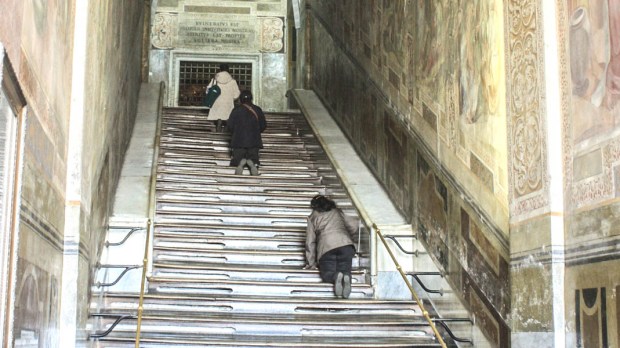Lenten Campaign 2025
This content is free of charge, as are all our articles.
Support us with a donation that is tax-deductible and enable us to continue to reach millions of readers.
For centuries, pilgrims visiting Rome have made a visit to the Pontifical Sanctuary of the Holy Stairs a must-do item on their bucket lists. There they ascend the hard marble stairs on their knees while praying and meditating on the Passion of Jesus.
The popular devotion is based on an ancient Christian tradition that tells us that St. Helena, the mother of Emperor Constantine, had the 28 steps which Jesus is said to have climbed on the day he was sentenced to death by Pontius Pilate transported to Rome in 362.
Pilgrims climb the steps, known as the “Scala Pilati” or “Scala Sancta” (Pilate’s Stairs or the Holy Stairs), on their knees as an act of penitence and then visit the Sancta Santorum, the first private papal chapel and the home of some of the Church’s most sacred relics.
Some 18,300 square feet of frescoes featuring stories from the Old and New Testament surround the stairs. Installed in 1589 by Pope Sixtus V to educate the mostly illiterate pilgrims visiting the stairs in their faith, the frescoes have grown dingy and in need of repair.
“Since the faithful often did not read or write, the stories came to life” through images, Mary Angela Schroth, a Rome art gallery curator, told Catholic News Service.
Take a look at this video of the Holy Stairs before their restoration. The marble steps were encased in a protective wooden covering with occasional openings where the marble could be touched:
For the next year, they will be closed to the public while the staircase restoration project is completed.
Modern-day vistors to the Holy Stairs tend to ignore the frescoes all together focus more on prayer while ascending the stairs, says Paul Encinias, director of the Rome-based Eternal City Tours.
“Twenty-first century Catholic pilgrims are far removed from artistic narratives,” he told CNS.
They are “not used to these visual cues” found in the frescoes, he added.
Perhaps the much-needed face-lift will redirect pilgrims’ interest to the beautiful paintings installed for them by a 15th-century pope.

